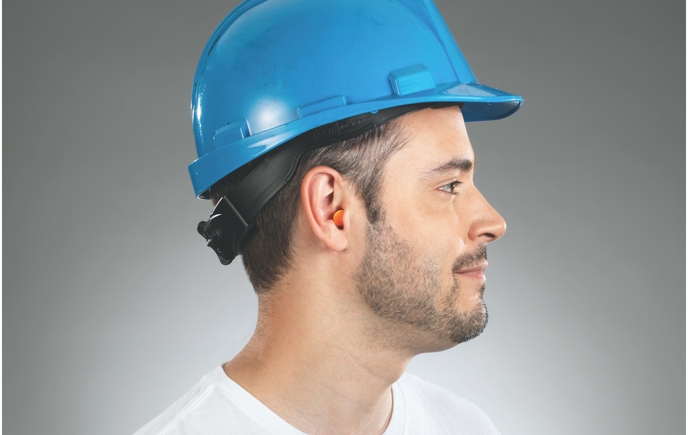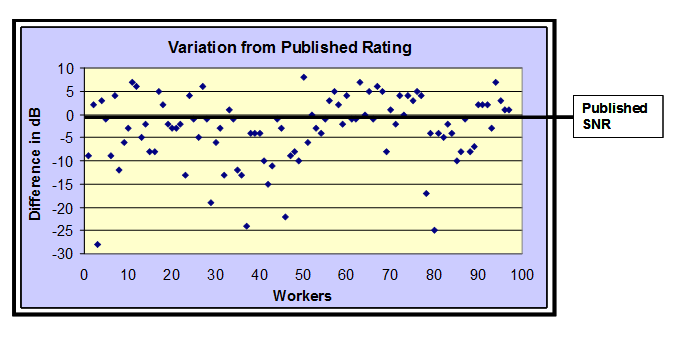Full steam ahead - Scottish distillery with Grundfos
There’s steam and there’s high-quality steam. There are pump solutions and intelligent pump solution...
Let’s try a quick quiz. Your facility has continuous noise measuring 100 decibels (dBA) - a hazardous noise level. Your worker wears an earplug with a rating number on the package of 30 dB. How much noise is reaching the eardrum of the worker? If you answer 70 dB, you are probably quite far off.

It’s a question that strikes at the core of hearing conservation efforts, yet most safety professionals have little idea how much protection is obtained by a noise-exposed worker. In fact, very few workers themselves would know how much protection they are achieving. The Single Number Rating (SNR) on the package is intended to estimate the protection level a particular earplug is capable of delivering in idealised laboratory conditions when it is properly fit. But repeated studies show that in the real world of industrial noise, exposed workers sometimes only obtain a fraction of that rating number ... perhaps 5 dB or less, not the 30 dB on the package.
The reasons for this real-world discrepancy are numerous, but with regard to earplugs, they can be summarised into two major culprits: poor fitting technique, not inserting the earplug far enough into the ear canal to block noise adequately, or bad selection, choosing the wrong earplug that is not a good fit for that particular ear.
Many well-intentioned managers follow best practice in offering hearing protectors and administering audiometric testing to noise-exposed workers. But they are often surprised to find that their efforts simply document the progression of hearing loss, rather than prevent the loss. The following myths underlie many of these false expectations.
Many safety managers falsely assume that proper use of hearing protection is fairly intuitive (“just put it in your ear”). They pass out the hearing protection, but provide little or no training in how to use that protection properly, perhaps generously assuming that workers will read the manufacturer’s instructions on the package.
A comprehensive study of hearing protector use in UK revealed that when Hearing Conservation training had been provided by posters or leaflets, less than half of the “trained” workers could recall even basic aspects of the content.1 But repeated studies show that if that same training is delivered individually, one-on-one or in small groups, the worker’s recall of the content skyrockets, and the worker is significantly more likely to obtain higher levels of protection. Large group training seems to have little effect in proper usage of hearing protection; only individual training can be linked to high attenuation results.
Many safety managers assume anything in the ear canal must be blocking some noise. But acoustic testing proves that a leaky earplug (one that does not seal the ear canal) often provides very little or no protection. This is problematic for a safety manager who is trying to evaluate compliance by visual inspections. He/she might assume that any worker wearing an earplug must be protected to some extent, and focus more on the workers who are wearing no protection at all. But in reality, a poorly-fit earplug may offer no protection, just like the worker with no earplug.
Since the SNR was developed, numerous studies have shown that average attenuation achieved in the noisy workplace is sometimes far below the laboratory-generated SNR. This may be due to several critical factors: users in the real world might not receive proper training, or may adjust their protectors for comfort rather than protection. Some users may intentionally compromise their fit in order to optimize their ability to hear co-workers and machine noises more clearly.
In response to this real-world disparity, a number of agencies have proposed various SNR de-rating schemes to better predict performance of hearing protectors in the ears of users in the workplace. An earplug that carries an SNR of 30 dB on the package, for example, may be given “credit” for only 23 dB, 15 dB, or 11 dB, depending upon which of the contradictory de-rating methods is applied. But all de-rating schemes are only guesses. In the end, the performance of a hearing protector worn by an individual in the workplace is completely impossible to predict using any laboratory rating method, with or without de-ratings.
Instead of relying upon the laboratory estimates of the SNR, a safety manager can now measure each worker’s protection level on-site. At least five manufacturers currently offer fit-test systems for hearing protection, allowing a safety manager to document exactly how much protection a worker receives with a given earplug. The result is a Personal Attenuation Rating (PAR). But that PAR is specific only to that earplug, that worker and that particular fit.
Benefits of fit-testing of hearing protectors were highlighted in a recent Best Practices Bulletin published by an alliance of regulatory agencies in the U.S. and the National Hearing Conservation Association. The document (available from the website cited below2) endorses fit-testing as a best practice in a Hearing Conservation Programme, and cites the major benefits, including employee training, refitting of workers with declining hearing and selecting adequate hearing protectors for specific noise environments.
Various fit-testing systems use different methods to measure real-world protection from an earplug. Some use specially-prepared surrogate earplugs with probe microphones, while others can test any earplug from any manufacturer. Some systems require a quiet test room, similar to audiometric testing, while others can be performed in any office or lunchroom. But the end result of these fit-test systems is a personalised measure of real-world protection, similar in concept to a respirator fit test.
The value of fit-testing is immediate and powerful. If a worker obtains a low Personal Attenuation Rating (poor fit), hands-on re-instruction and re-fitting can be performed immediately. If re-training with the same earplug fails to improve the Personal Attenuation Rating, then a different earplug can be selected to more closely match the user’s ear canal anatomy (perhaps trying a smaller earplug to match a smaller ear canal, or selecting a foam earplug that can adapt to an oval-shaped ear canal better than a round pre-formed earplug). Within a few minutes, a worker can complete a fit-test on several earplugs, and select the one that proves to offer the most protection without sacrificing comfort.
In a study using one of these earplug fit-test systems, VeriPRO® from Howard Leight by Honeywell, 100 noise-exposed workers at eight different companies were asked to fit the earplug they typically wear, inserting it in the customary manner. Workers wore a variety of earplugs from several different manufacturers. One-third of the tested workers achieved real-world attenuation that was equal to or higher than the package rating for their respective earplug. The middle third of workers achieved attenuation within 5 decibels below the package rating, and the bottom third of workers showed real-world attenuation anywhere from 5-30 decibels below the published rating for their selected earplugs.

Figure 1. Real-world attenuation values from 100 noise-exposed workers at eight facilities (each dot on the plot represents one worker). Solid line indicates the published rating (SNR) for the respective earplug used by the workers. Nearly two-thirds of workers achieved attenuation values lower than the published rating. (From Howard Leight Acoustical Test Lab, San Diego, 2008).
The study then interviewed the workers who obtained high attenuation values to determine the common factors that contribute to good earplug fit, and hence, good protection from hazardous noise. Only one factor was found to be a consistent predictor of good fit: one-on-one training. That is, any worker who had received individual training in the proper fitting of hearing protectors was far more likely to fit the earplugs better. The same effect was not true for group training, such as watching annual training videos or passing out brochures.
In a recent evaluation of a fit-test system, INSPEC International Limited (UK) stated that “the system appeared to have the potential to aid correct fitting and selection of earplugs.”3 Further, INSPEC validated that “the data demonstrated that it would be a useful tool for ensuring Hearing Conservation within the workplace.”
Most importantly, fit-testing has an immediate and lasting effect upon the noise-exposed worker. In a recent fit-test study involving over 1,500 workers in manufacturing facilities, a post-test survey found that 84% of workers stated they were better able to fit their earplugs. The post-test survey cards also included many unsolicited comments from the workers: “I learned I’ve been using my earplugs wrong my whole career.” “Just learned how to effectively roll the plug before insert.” “I’ll put a little more effort and get them deeper!” “Amazed at difference with proper fit.”
Noise-induced hearing loss is not the automatic by-product of a noisy workplace. By implementing leading indicators in a Hearing Conservation Programme, employers are empowered to prevent noise-induced hearing loss, rather than just documenting it through audiometric testing. Best practices like individual fit-testing provide safety managers with immediate and lasting training tools that allow employers to say with confidence, “We stopped hearing loss in our workplace.”
Get the latest updates from ERIKS including:
Choose any or all of these via the ERIKS Subscription Centre!
Our Know+How brings together the best of the latest Know+How Hub articles in one easy to digest magazine, covering the following topics:
That's why its the leading magazine for maintenance engineers from ERIKS.
Want Know+How Magazine delivered direct to your door? Visit the ERIKS Subscription Centre to opt-in!
Take a look at our latest updates...
There’s steam and there’s high-quality steam. There are pump solutions and intelligent pump solution...
Looking for a custom Product quote? Need an answer to a Technical question? Looking for Careers/HR support? Want to work with us? Interested in our Digital Trading solutions? Have a finance question? Send us your enquiry and a member of the ERIKS team will be with you quickly.
We strive to deliver exceptional quality service and products. As part of this goal, we encourage customers to submit feedback on their experiences so we can resolve any issues and concerns.
At ERIKS we strive to deliver the best quality service and products. As part of this goal we encourage customers to submit feedback on their experiences so we can resolve any issues and concerns.
Call us: +441215086000
